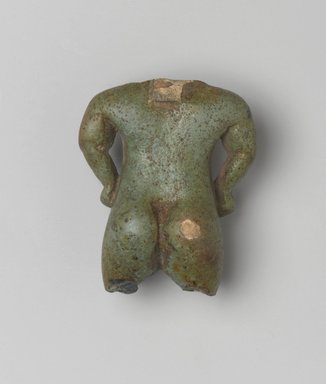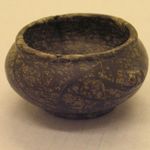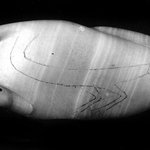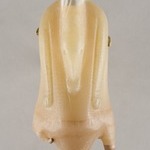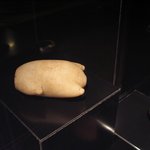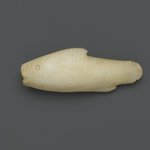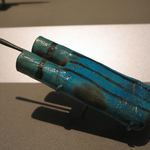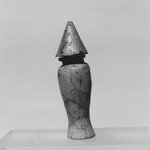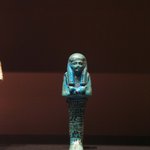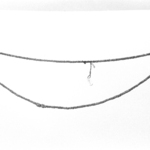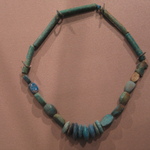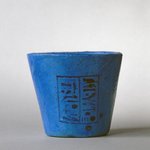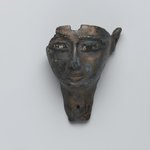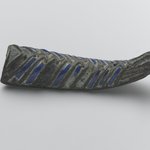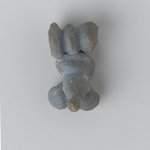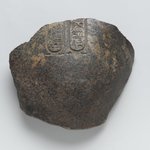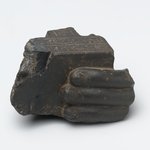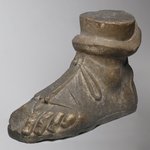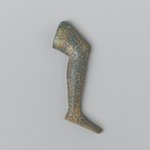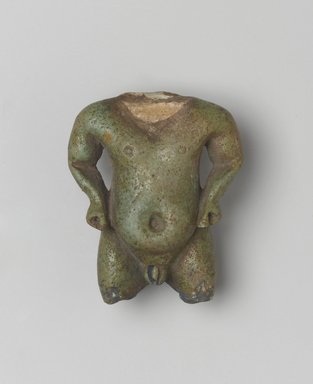

Fragmentary Amulet of Pataikos, ca. 1539–30 B.C.E. Faience, 1 15/16 x 1 1/2 in. (5 x 3.8 cm). Brooklyn Museum, Brooklyn Museum Collection, X1182.2. Creative Commons-BY (Photo: Brooklyn Museum, X1182.2_front_PS2.jpg)
Fragmentary Amulet of Pataikos
Egyptian, Classical, Ancient Near Eastern Art
The ancient Egyptians regarded short stature as a mark of divinity. They associated the physical characteristics of achondroplasia (a type of dwarfism) with the sun god Re. In Egyptian mythology, Re died in the evening and was reborn every morning as a wise, experienced, yet youthful god. The symbol of the morning sun, the scarab, evoked the silhouette of a large torso with short, curved limbs.
This fragmentary amulet is an example of religion and magic practiced by regular Egyptians. As timeless symbols of rebirth, images of Pataikos and other gods of short stature protected women and children during dangerous times of transition, especially pregnancy and birth, repelling evil and aiding regeneration.
This fragmentary amulet is an example of religion and magic practiced by regular Egyptians. As timeless symbols of rebirth, images of Pataikos and other gods of short stature protected women and children during dangerous times of transition, especially pregnancy and birth, repelling evil and aiding regeneration.
MEDIUM
Faience
DATES
ca. 1539–30 B.C.E.
PERIOD
New Kingdom or later
DIMENSIONS
1 15/16 x 1 1/2 in. (5 x 3.8 cm) (show scale)



COLLECTIONS
Egyptian, Classical, Ancient Near Eastern Art
ACCESSION NUMBER
X1182.2
CREDIT LINE
Brooklyn Museum Collection
MUSEUM LOCATION
This item is not on view
CAPTION
Fragmentary Amulet of Pataikos, ca. 1539–30 B.C.E. Faience, 1 15/16 x 1 1/2 in. (5 x 3.8 cm). Brooklyn Museum, Brooklyn Museum Collection, X1182.2. Creative Commons-BY (Photo: Brooklyn Museum, X1182.2_front_PS2.jpg)
IMAGE
front, X1182.2_front_PS2.jpg. Brooklyn Museum photograph, 2009
"CUR" at the beginning of an image file name means that the image was created by a curatorial staff member. These study images may be digital point-and-shoot photographs, when we don\'t yet have high-quality studio photography, or they may be scans of older negatives, slides, or photographic prints, providing historical documentation of the object.
RIGHTS STATEMENT
Creative Commons-BY
You may download and use Brooklyn Museum images of this three-dimensional work in accordance with a Creative Commons license. Fair use, as understood under the United States Copyright Act, may also apply.
Please include caption information from this page and credit the Brooklyn Museum. If you need a high resolution file, please fill out our online application form (charges apply).
For further information about copyright, we recommend resources at the United States Library of Congress, Cornell University, Copyright and Cultural Institutions: Guidelines for U.S. Libraries, Archives, and Museums, and Copyright Watch.
For more information about the Museum's rights project, including how rights types are assigned, please see our blog posts on copyright.
If you have any information regarding this work and rights to it, please contact copyright@brooklynmuseum.org.
RECORD COMPLETENESS
Not every record you will find here is complete. More information is available for some works than for others, and some entries have been updated more recently. Records are frequently reviewed and revised, and we welcome any additional information you might have.
